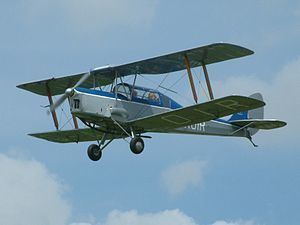Top speed 164 km/h Length 7.62 m First flight 1957 | Wingspan 9.25 m Manufacturer Jackaroo Aircraft Limited | |
 | ||
The Thruxton Jackaroo was a 1950s British four-seat cabin biplane converted from a de Havilland Tiger Moth by Jackaroo Aircraft Limited at Thruxton Aerodrome and Rollason Aircraft and Engines Limited at Croydon Airport.
Contents
The magic of shuttleworth thruxton jackaroo g aoir
History
The Thruxton Jackaroo was designed as a four-seat cabin general purpose biplane. The first conversion first flew on 2 March 1957. Eighteen Tiger Moths were converted by Jackaroo Aircraft Limited between 1957 and 1959 and one aircraft was converted by Rollason's in 1960. Three aircraft were equipped with crop spraying gear. In 1963 and 1964 the Greenjackets sport-parachute club regularly used a Thruxton Jackaroo for sky-diving activities at Thruxton airfield.
Variants
Specifications
Data from De Havilland Aircraft since 1909
General characteristics
Performance
